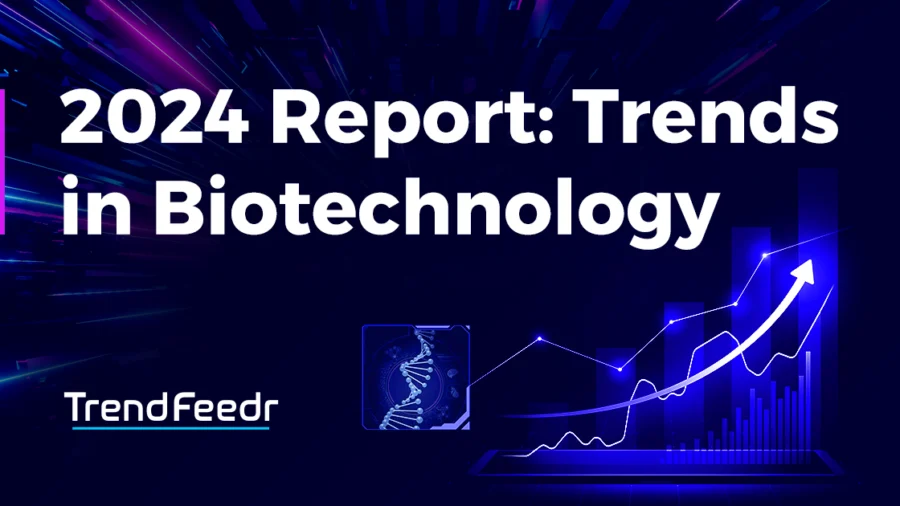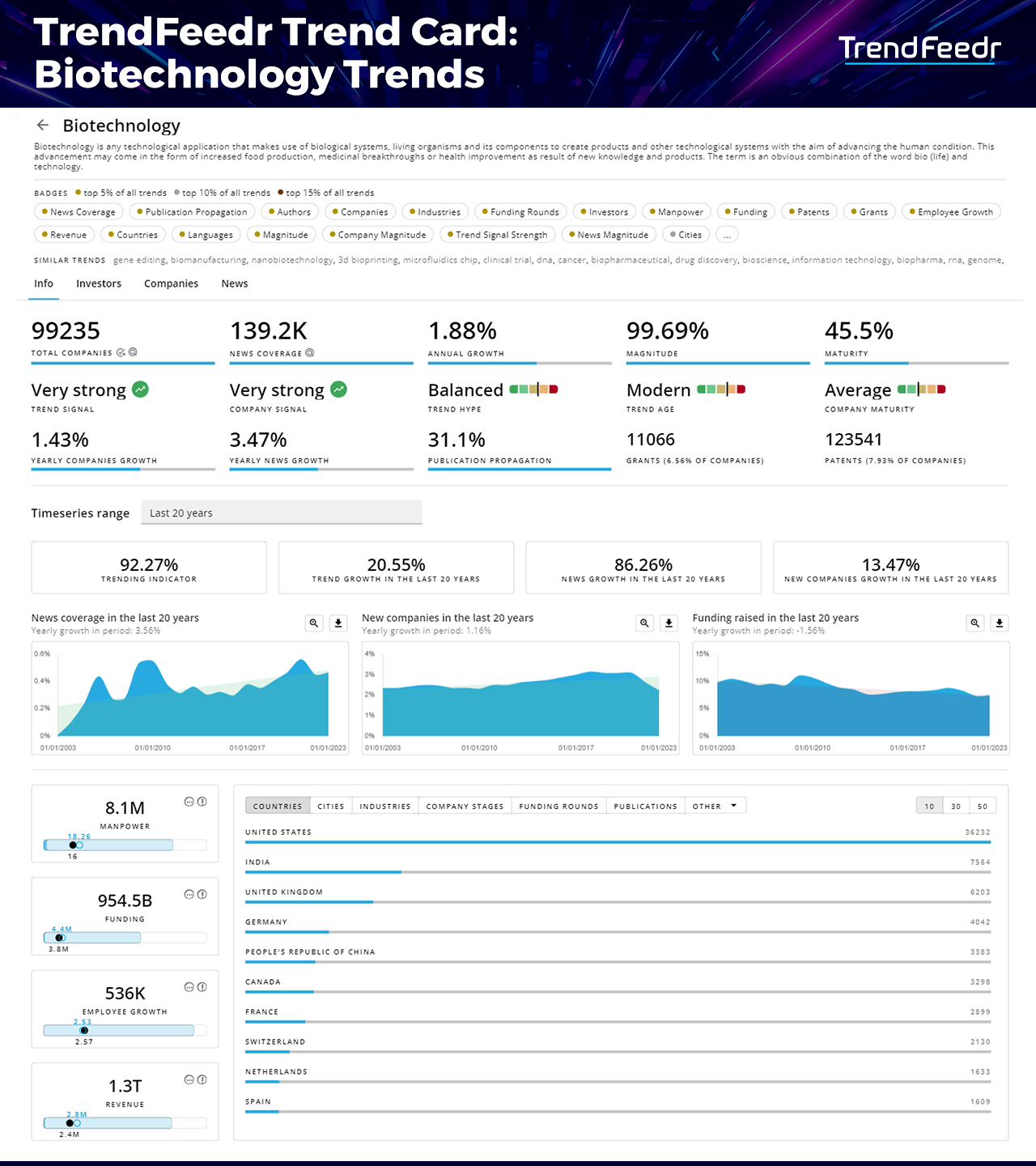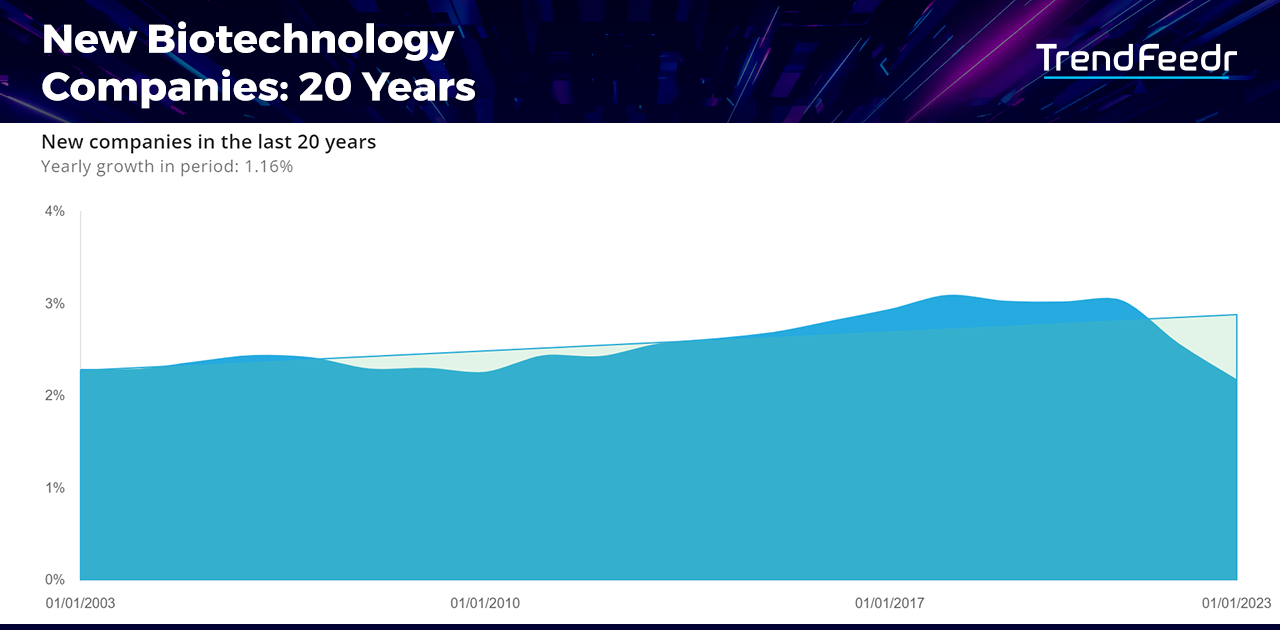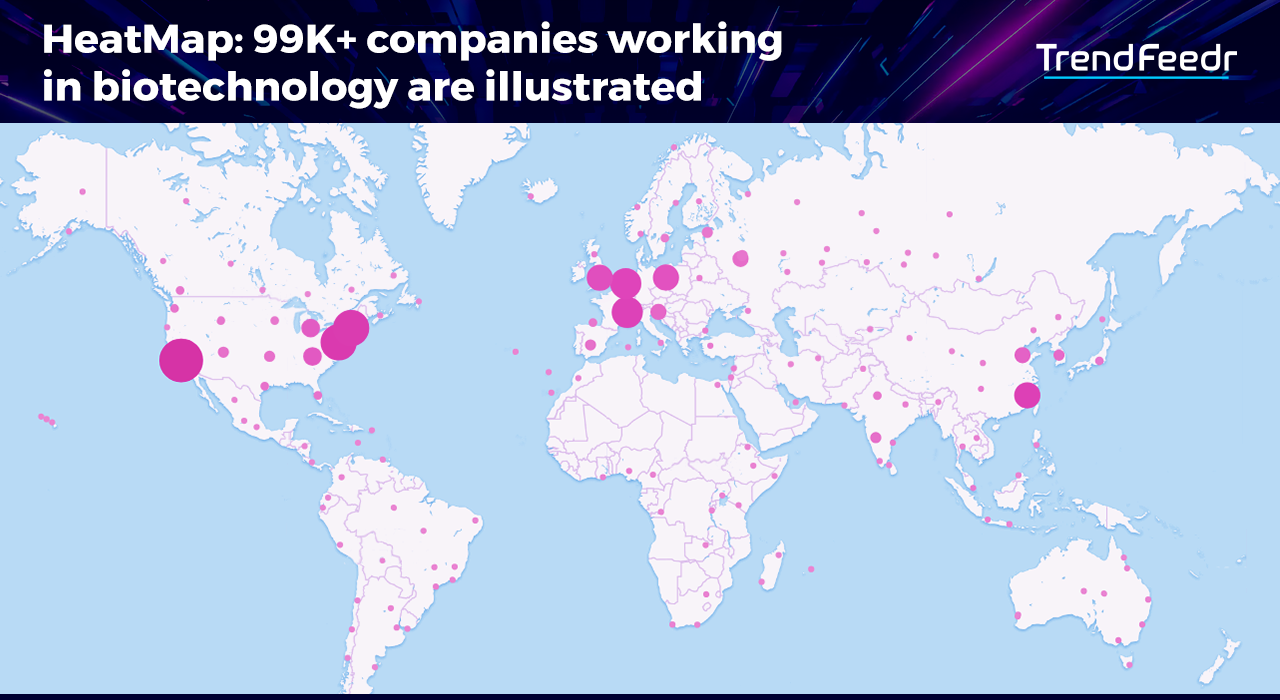The progress in science and technology is shaping our future, with the biotechnology sector standing out as a crucial participant. This report on trends in biotechnology examines the industry’s trajectory, underlining its role in providing innovative solutions across diverse sectors. Recent advancements in the industry demonstrate a deep understanding of modern-day challenges and opportunities. Take, for instance, the creation of state-of-the-art therapies, sustainable farming methods, and environmentally friendly solutions for conservation.
Major progress in genetic engineering, specifically CRISPR, is revolutionizing the approach to medical treatments and crop enhancement. These developments in precision medicine and sustainable agriculture also address vital global concerns such as health emergencies and food security. Further, the utilization of AI, machine learning, and big data analytics in biotechnology research is expediting discoveries while increasing the efficiency of various procedures.
Echoing the industry’s dynamic expansion, recent biotechnology market research forecasts a bright future. According to Grand View Research, the global biotechnology market, valued at US$1.37 trillion in 2022, is projected to witness substantial growth by 2030, with a CAGR of 13.96%. These biotechnology market trends underscore the industry’s swift adaptation to emerging trends and its steadfast dedication to spearheading innovation.
In this data-driven biotechnology trends report, we delve into the current trends in biotechnology, focusing on gene editing, biomanufacturing, nanobiotechnology, 3d bioprinting, and microfluidic chips.
Key Takeaways
- Prominent Trend: With a trend magnitude of 99.69% and a trend maturity of 45.5%, according to TrendFeedr, biotechnology is at the forefront of scientific advancement.
- Diverse Technological Focus: Biotechnology companies are expanding their focus to include emerging trends such as gene editing, biomanufacturing, nanobiotechnology, 3D bioprinting, and microfluidic chips.
- Escalating Media Attention: The consistent annual growth of 3.56% in news coverage over the last 20 years underlines biotechnology’s increasing relevance and public interest.
- Robust Organizational & Financial Growth: Approximately, 99,000 entities are actively participating in biotechnology, collectively attracting investment capital of around US$1.3 trillion.
- Significant Investment Influx: Major investors such as RA Capital Management, OrbiMed, and SoftBank Vision Fund are infusing billions into pioneering biotechnology ventures.
- Global Reach & Innovation Hubs: Leading countries in biotechnology include the United States, India, the United Kingdom, Germany, and China. Key cities such as New York City, London, Cambridge, San Francisco, and San Diego are also emerging as major hubs of innovation and research.
Table of Contents
- Understanding Biotechnology Trends
- Biotechnology Trend Card
- 5 Key Biotechnology Trends
- Emerging Trends & Technologies Disrupting the Biotechnology Industry
- 5 Emerging Biotechnology Companies
- Biotechnology Investment Trends
- Mapping Global Biotechnology Companies
- Media Coverage of the Biotechnology Industry
- Future of Biotechnology
For this detailed analysis of material trends, we use TrendFeedr, our all-in-one trend intelligence platform. TrendFeedr uses advanced algorithms to identify future industry and tech trends. With a focus on trend discovery, clustering, and analysis, the AI-powered platform reviews thousands of trends each week to provide actionable insights.
Among more than 20,000 trends and technologies monitored by TrendFeedr, biotechnology has made a significant impact. Here’s why:
- Biotechnology is in the top 1% of global trends, ranking within the top 100 trends. This demonstrates its crucial role in improving life quality and promoting sustainability.
- With a maturity level of 45.5%, the biotechnology industry is marked by a dynamic blend of emerging startups and some established organizations.
- Contributing to the development of groundbreaking healthcare treatments, sustainable agricultural practices, and environmental conservation strategies, biotechnology is instrumental in tackling the world’s urgent challenges.
This biotech trends report explores performance, investment, regional, and future outlook.
Understanding Biotechnology Trends
Biotechnology, a rapidly evolving field at the crossroads of biology and technology, is reshaping healthcare, agriculture, environmental management, and more.
What are the trends in biotechnology?
One of the most transformative trends in recent years is gene editing, particularly CRISPR-Cas9. It alters DNA with precision and is crucial in creating new therapies for genetic disorders and enhancing crop resilience, for example. Synthetic biology, another trend, involves reengineering organisms for specific uses by giving them new capabilities. This is driving the creation of new bio-based materials, sustainable fuels, and groundbreaking medical treatments.
The move towards personalized medicine, fueled by genomics advancements, is customizing healthcare to individual genetic profiles. This leads to more effective and targeted treatments. Biomanufacturing, which uses living cells to produce products, is also revolutionizing the production from pharmaceuticals to food, emphasizing sustainability and efficiency.
What are new technologies in biotech?
Progress in biotechnology is enabled by new technologies, which facilitate novel research and applications. For instance, nanobiotechnology combines nanotechnology and biology to improve drug delivery, diagnostics, and tissue engineering. Microfluidic and lab-on-a-chip devices shrink and automate lab processes on a chip, reducing sample size and speeding up research and diagnostics.
3D bioprinting generates living tissues for tissue engineering and regenerative medicine. The ultimate goal of this technology is to create functional organs for transplantation. Lastly, AI and machine learning algorithms expedite drug discovery by forecasting disease patterns and analyzing biological data.
Biotechnology Trend Card: Explore the Most Recent Developments in the Biotech Landscape
The Biotechnology Trend Card provides an overview of the sector’s performance and emerging patterns:
Looking for all trends related to biotechnology?
- Industry Footprint: Representing a vast network, biotechnology boasts 99,235 companies worldwide, indicating its extensive impact across multiple disciplines.
- Growth and Evolution: The sector shows a promising trend growth of 20.55% over two decades and a maturity level of 45.5%, pointing to its potential for further innovation and market expansion.
- Public and Media Engagement: The significant media presence, with an 86.26% increase in news coverage in the last 20 years, reflects a keen interest in biotechnological developments.
- Emergence of Innovators: The industry’s growth is marked by a 13.47% increase in the number of new companies in the last two decades, suggesting a fertile ground for startups and new ventures.
- Financial Confidence: Attracting US$954.5 billion in funding, the sector illustrates investor trust and the anticipation of continued industry success.
- Economic and Employment Contributions: With 8.1 million employees and US$1.3 trillion in revenue, biotechnology stands as a key player in the global economy and job market.
- Worldwide Influence: The industry’s presence is notable across major regions, with the United States, the United Kingdom, Germany, and China leading in innovation and market activity.
Dive into this data-rich biotechnology report as we uncover the sector’s latest trends and insights.
Key Biotechnology Trends & Firmographic Insights
The biotechnology sector employs approximately 8.1 million individuals globally. The average company size in this field is 105 employees, reflecting a prevalent medium-scale organizational structure. However, the median size of 16 employees indicates many smaller, more specialized, or startup companies. This enhances the diversity and dynamism of the biotech landscape.
Turning to annual employee growth, the industry’s addition of 536,000 employees is a robust indicator of its growth and the increasing demand for skilled professionals. An average annual growth of 8 employees per company, along with a median of 3, suggests a consistent expansion.
Here’s a spotlight on five pivotal trends transforming this sector. It includes insights into the count of engaged biotech firms, the aggregate investment in these domains, and the workforce committed to these trends.
1. Gene Editing
- Gene editing is a remedy for genetic disorders, a catalyst for crop enhancement, and a research tool for biological processes.
- This field has captivated 791 organizations, collectively garnering an impressive US$23.8 billion in funding.
- The sector employs a skilled workforce of 41.2K professionals, leading the charge in transformative healthcare solutions.
2. Biomanufacturing
- Biomanufacturing employs living cells or enzymes to generate pharmaceuticals and bioproducts via biological processes.
- This innovative approach has attracted 514 organizations, securing US$7.6 billion in investments.
- With a dedicated workforce of 52.5K, these companies are leading the way in eco-friendly industrial processes.
3. Nanobiotechnology
- Nanobiotechnology devises nanoscale instruments for diagnostics, drug administration, and cellular repair.
- This sector is pursued by 330 organizations, amassing funding of US$768.1 million.
- Employing 11.7K specialists, it’s driving significant advancements in healthcare and beyond.
4. 3D Bioprinting
- 3D bioprinting fabricates tissue and organ structures in a layer-by-layer manner using bioinks – intended for medical research and potential organ transplants.
- This niche has drawn the attention of 204 organizations, raising a total of US$481.1 million.
- With 5,227 professionals, it’s making strides towards a future of personalized organ transplants.
5. Microfluidic Chips
- Microfluidic chips control minute fluid volumes within microchannels, utilized in lab-on-a-chip devices and high-throughput screening.
- 173 organizations are actively involved, with an investment total of US$1.7 billion.
- This field employs 4,326 experts, contributing to breakthroughs in diagnostics and research methodologies.
How Do Emerging Trends & Technologies Disrupt the Biotechnology Industry?
Biotechnology is witnessing a paradigm shift with the advent of novel technological trends and breakthroughs. Let’s delve into these game-changing progressions in the realm of biotechnology.
1. Gene Editing
Gene editing involves making precise changes to the DNA sequence of a living organism. This is achieved using specialized technologies, such as enzymes engineered to target specific DNA sequences. This approach involves inserting, deleting, modifying, or replacing DNA in an organism’s genome. For instance, it creates organisms with desired traits for treating genetic disorders.
Amber Bio, for example, offers gene editing modalities using multi-kilobase RNA writing. The startup addresses a wide range of mutations in genetic medicine. The solutions are biologically inspired to treat complex diseases more effectively. It enables medical researchers to develop independent therapies for each separate mutation in the patient population.
2. Biomanufacturing
Leveraging biological systems, such as microbes, animal cells, or plant cells, biomanufacturing produces biomaterials and biomolecules. These biomanufactured products have a wide range of applications. It includes amino acids and biopharmaceuticals in medicine and enzymes and protein supplements in food and beverage processing.
Startups such as TAAV Biomanufacturing Solutions specialize in enzymatic DNA production. It offers solutions for the biopharmaceutical industry, focusing on gene therapies based on adeno-associated virus (AAV) technologies. Its neDNA offers an alternative to traditional plasmids for AAV production, providing critical materials to expedite gene therapy development.
3. Nanobiotechnology
Combining nanotechnology and biotechnology allows researchers to create nanoscale devices and systems for biological research. Nanobiotechnology employs nanoscale materials to investigate biological systems and innovate medical technologies. Its applications range from disease diagnosis and treatment to the biosynthesis of metal nanomaterials for sustainability.
For instance, Helix Biotech, a startup, specializes in formulating and delivering pharmaceuticals via nanotechnology. It produces lipid nanoparticle systems for encapsulating RNA, DNA, and small molecules. Its solutions serve diverse sectors including pharmaceutical, nutraceutical, and cosmetic industries.
4. 3D Bioprinting
3D bioprinting employs techniques akin to 3D printing to construct biomedical structures. It amalgamates cells, growth factors, and biomaterials to replicate natural tissue traits. It is used for the creation of organs and tissues for drug testing and the development of treatments.
CELUTRON, for example, is leveraging 3D bioprinting, particularly focusing on stem cell-driven technology. The startup builds reconfigurable 3D bioprinters and patient-specific bioink. It reconstructs organs tailored for research purposes, supporting both therapeutic and research needs.
5. Microfluidic Chips
Microfluidic chips, or ‘lab-on-a-chip’ technology, control minute fluid volumes via microchannels. Crafted from materials like glass, silicon, or polymers, these chips serve diverse applications such as sample processing, separation, and detection. They are used in biological and chemical testing, medical diagnostics, and food safety monitoring.
For example, AKSO Biotech develops microfluidic chip technology. It explores new applications of high-throughput microfluidics and microsphere products. The startup expedites the creation and utilization of diverse microsphere types and materials.
5 Emerging Biotechnology Companies
The above time series chart, illustrating the yearly growth in the number of organizations, reveals a consistent rise of 1.16% over the past two decades. This underscores the sector’s escalating allure and feasibility, as both an innovation hub and a commercial prospect.
5 Promising Biotechnology Startups
Biotechnology startups are pioneering the use of biological systems and organisms to create impactful technologies and products. These innovations are transforming healthcare, agriculture, and environmental sustainability. These startups are also developing groundbreaking medical therapies and diagnostics. Let’s explore five biotechnology startups established in the last five years and their contributions to biotechnological advancements.
- CellVoyant utilizes AI-driven live cell imaging for predicting and optimizing stem cell differentiation, enabling the scalable production of any cell and tissue in the body.
- 5M BIOMED develops and delivers molecular and biomarker-specific medical imaging technology, in vitro diagnostics, and drug delivery for the biomedical communities and healthcare industry.
- Jizhi Gene provides products and services in gene sequencing, biological information analysis, biological cloud analysis platforms, and intelligent breeding design.
- Monod Bio creates biosensors for detecting proteins, toxins, antibodies, and other molecules, facilitating their use in biotechnology and medicine.
- Akrocell Bioscience produces cell sheet products for diverse applications, including wound healing, tissue engineering, and regenerative medicine.
Biotechnology Investment Trends
Biotechnology is excelling in funding, ranking in the top 5% of over 20K trends and technologies tracked by TrendFeedr.
The above time series chart shows a yearly funding decline of 1.56% over the past two decades. This indicates market fluctuations, changes in investment strategies, or shifts in biotech research and development focus.
A Closer Look at the Financials
TrendFeedr data on the biotechnology industry reveals total funding to be US$954.5 billion. The highest funding for a single entity is US$3.8 billion, as seen with Lotte Corporation. The average funding per company is US$43.6 million, while the median is lower at US$3.8 million.
In terms of revenue, TrendFeedr estimates the biotechnology industry generates around US$1.3 trillion. The highest revenue for a single entity is US$1.8 billion, as recorded by PSA BDP International. The average revenue per company is approximately US$16.5 million and the median revenue is US$2.4 million.
Approximately, 22.05% of biotechnology firms received funding, making the diversity in funding rounds crucial for industry growth. Early-stage VC or Series A funding is vital for biotech startups, offering the necessary capital to expand their operations. Grants, which account for 6.56% of biotech companies, play a key role in supporting early-stage R&D.
Seed funding acts as the initial financial support for companies transitioning from concepts to viable businesses. Venture rounds are crucial for biotech companies to broaden their research and market presence beyond the initial stages. Lastly, later-stage VC or series C funding supports more established companies, assisting in their significant scaling up or preparing for events like IPOs.
Prominent Investors in the Biotechnology Sector
RA Capital Management is a leading investor in the field, with investments of US$5.1 billion across 82 companies. Its significant investments include Invivyd at US$336 million and Verona Pharma at US$200 million, demonstrating its commitment to promoting biotechnological R&D.
OrbiMed has invested a total of US$3.8 billion in 92 companies. Its substantial funding for Caris Life Sciences at US$400 million and Upstream Bio at US$300 million reflects its strategic focus on innovative biotech ventures.
SoftBank Vision Fund has invested US$2.9 billion across 19 companies. Its major investments in Relay Therapeutics at US$400 million and Nature’s Fynd at US$350 million highlight its interest in cutting-edge biotechnology solutions.
Public investment in biotechnology is also significant, totaling US$15.4 billion across 281 companies. Major investments include US$578.9 million in Shandong Sanyuan and US$462.5 million in Yunnan Botanee Bio-Technology Group, showcasing the diverse nature of public sector investment in this sector.
Further, the number of unique investors in the biotechnology sector ranks in the top 5% across all trends. This reflects the sector’s diverse and robust investor interest. It also underscores the sector’s strong potential for innovative breakthroughs and profitable returns.
Mapping Biotechnology Companies around the Globe
Our heatmap provides a detailed snapshot of the present state of biotechnology, spotlighting around 99,000 companies at the forefront of innovations in this field.
Interested to explore all 99K+ biotech companies?
The United States houses many biotech firms, reflecting its strong commitment to research and development, and a favorable regulatory environment. India and the U.K. are not far behind, with a noticeable rise in biotech companies. This indicates their increasing focus on healthcare innovation and supportive government policies. Germany, known for its solid foundation in scientific research and engineering, holds a consistent position in the biotech field. China has demonstrated impressive growth in recent years, driven by significant government funding.
On a city scale, New York City and San Francisco remain strongholds in the biotech sector. Their combination of academic prowess, availability of venture capital, and entrepreneurial culture makes them appealing centers for both biotech startups and established companies. London, with its deep-rooted history in medical research and a thriving startup scene, has witnessed a substantial increase in biotech activities. Cambridge continues to be a crucial hub for biotech innovation, especially in genomics and pharmaceuticals. San Diego has also established a unique position for itself, particularly in biopharmaceuticals and genomics. It is propelled by robust academic-industry collaborations and a business-friendly environment.
Media Coverage for Biotechnology Sees a Yearly Uptick of 3.56% Over the Last 20 Years
The biotechnology sector has progressively garnered media attention over the past two decades. This escalating interest is quantitatively demonstrated by the 3.56% annual growth in news article coverage during this period.
It also excels in publication coverage, ranking in the top 5% of all trends, underscoring its escalating importance and influence in the scientific community. With a remarkable 138,815 articles from 2005 to 2023, biotechnology ranks in the top 5% of all trends in terms of article volume.
What is the Future of Biotechnology?
Given the current trajectory and data on biotechnology trends, several informed predictions of this dynamic field are made. Here’s the biotechnology outlook:
1. Genomics Revolutionizes Personalized Medicine
The incorporation of genomics into medicine is paving the way for personalized healthcare. By comprehending an individual’s genetic makeup, treatments, and medications are specifically tailored to them, enhancing effectiveness and minimizing side effects.
This personalized approach holds particular promise in oncology, where cancer treatments are customized to target specific genetic mutations. Further, genomic insights are laying the groundwork for preventive medicine, where potential health risks are identified and mitigated before they become apparent.
2. Expansion of AI and Machine Learning Applications
AI and machine learning are transforming biotechnology by facilitating the analysis of large datasets, such as genomic sequences, more efficiently. These technologies are assisting in drug discovery by predicting how various drugs will interact with different genetic markers.
AI is also playing a significant role in streamlining the radiation therapy planning process, leading to time efficiency and enhanced patient care. Additionally, machine learning models complex biological systems to provide insights into diseases at a molecular level.
3. Global Expansion drives Advances in Science & Health
Emerging economies are investing in biotech sectors, contributing to diverse research perspectives and innovation. This global expansion is not only advancing scientific knowledge but also addressing regional health challenges. An example of this development of new vaccines and treatments for tropical diseases, which have historically been overlooked.
Moreover, the democratization of biotech tools and knowledge is enabling low- and middle-income countries to develop tailored solutions to their unique health and agricultural needs.
4. Ethical and Regulatory Developments
As biotechnology progresses, it raises significant ethical and regulatory questions. The modification of genetic material, particularly in humans, presents profound ethical dilemmas regarding consent, equity, and the long-term impacts on the gene pool.
Regulatory bodies worldwide are striving to create guidelines that balance innovation with these ethical considerations. There’s also a growing need for public engagement and discourse to shape a societal consensus on acceptable practices in biotechnology.
5. Pioneering New Horizons through Interdisciplinary Collaborations
The merging of biology with fields like computer science, engineering, and physics is fostering innovative approaches to complex problems. For instance, the integration of nanotechnology with biomedicine is leading to breakthroughs in targeted drug delivery systems.
Similarly, collaborations between environmental science and biotechnology are crucial in developing sustainable biofuels and bioremediation strategies. These cross-disciplinary efforts address the multifaceted challenges that biotechnology aims to tackle.
Biotechnology Trends: Navigating the New Era of Scientific Breakthroughs
As we wrap up our report on trends in biotechnology, it is clear that we are moving through a rapidly changing landscape. The pace of discoveries is fast, and the range of possibilities seems endless. Keeping up with these changing trends is very important. It allows you to anticipate changes, take advantage of new opportunities, and stay ahead in a field that is shaping the future. But how do you do that?
Connect with biotech enthusiasts, industry leaders, and innovative creators; their insights can provide valuable perspectives and open up opportunities for collaboration. Dive into biotechnology market research reports, attend biotech-focused seminars and conferences, and participate in online biotech communities. Also, leverage trend-tracking tools, like TrendFeedr, that meticulously track up to 653 biotechnology sub-trends, offering a comprehensive view of the evolving biotechnology landscape.








